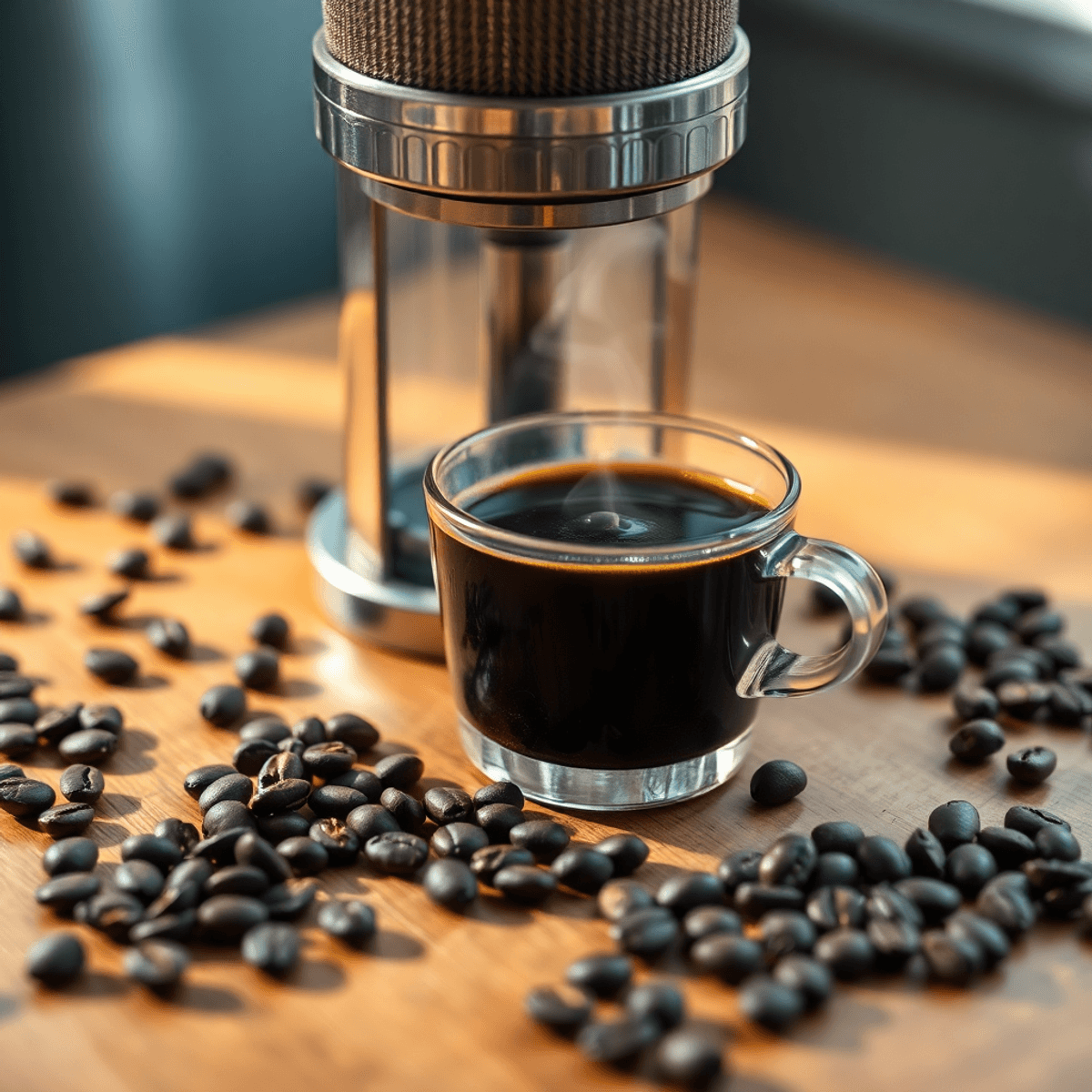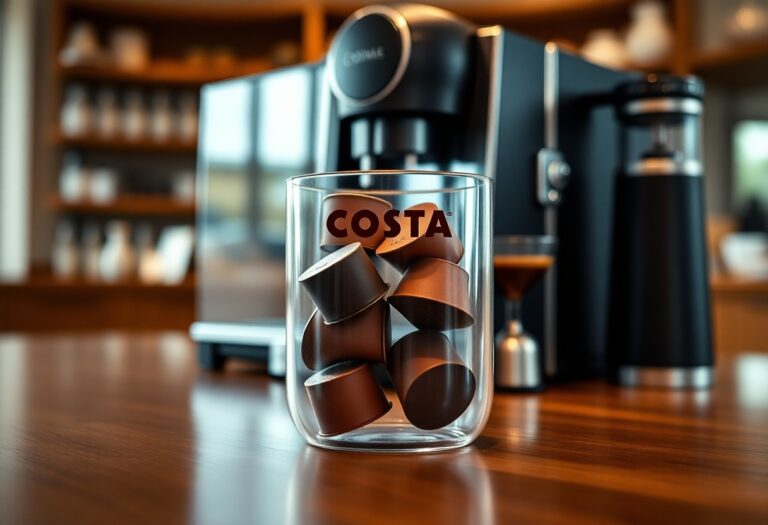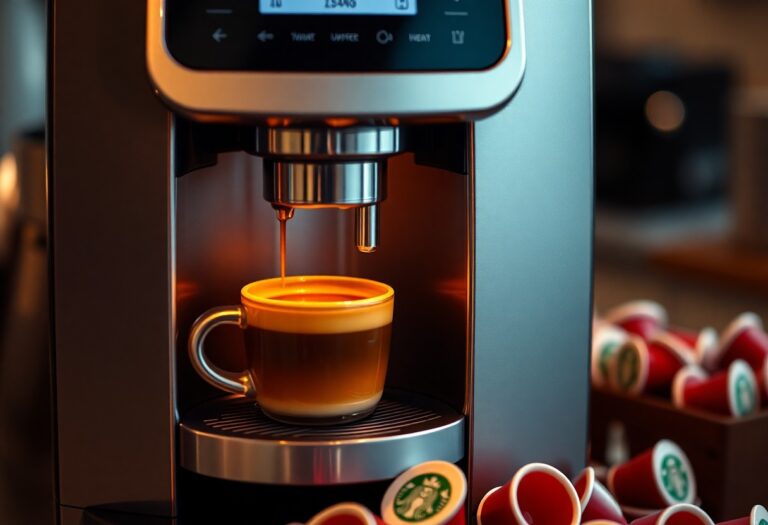How to Make Espresso Coffee Without an Espresso Machine
Traditional espresso-making involves forcing hot water through finely ground coffee under high pressure using an espresso machine.
Key takeaway: It is possible to make delicious espresso-style coffee at home without an expensive machine.
Alternative Methods for Making Espresso-Style Coffee Without a Machine
1. AeroPress
The AeroPress is a compact coffee device that has gained immense popularity among coffee enthusiasts for its versatility and ease of use. It uses manual piston pressure to force hot water through finely ground coffee, extracting a concentrated coffee shot that approaches the intensity of espresso. Many appreciate the AeroPress because it’s portable, affordable, and quick to clean.
How to Make Espresso-Style Coffee with AeroPress
- Coffee grind: Use finely ground dark roast coffee beans, similar in texture to table salt.
- Coffee-to-water ratio: A good starting point is 17 grams of coffee to 70 ml of water.
- Water temperature: Heat water to about 200°F (93°C), just off boiling.
- Brewing steps:
- Place a paper filter in the AeroPress cap and rinse it with hot water to eliminate any paper taste.
- Assemble the AeroPress in the inverted position (plunger at the bottom, chamber on top).
- Add your ground coffee into the chamber.
- Pour hot water over the grounds slowly, then stir gently for about 10 seconds.
- Attach the filter cap and carefully flip the AeroPress onto your cup.
- Press down steadily with manual piston pressure for around 20–30 seconds until you hear a hissing sound.
The resulting brew is strong, rich, and concentrated — closely resembling espresso with a smooth mouthfeel. Adjusting brewing time or coffee grind size can help you fine-tune flavor strength.
Many users enjoy experimenting with this method because it allows control over extraction variables without needing expensive equipment. The manual piston pressure plays a key role in mimicking an espresso machine’s pumping action, delivering a satisfying espresso-style shot right at home or on the go.
However, if you do own an espresso machine or any other type of coffee maker like a Keurig, Krups, or even a K-cup machine, it’s essential to maintain them properly for optimal performance. Regular cleaning and descaling are crucial steps in this process. For instance, if you’re looking for guidance on how to clean a K-cup coffee machine, check out these maintenance instructions. If you need detailed instructions on how to descale a Keurig coffee machine, this step-by-step guide will be helpful.
2. Moka Pot (Stovetop Espresso Maker)
The Moka Pot is a classic stovetop espresso maker renowned for its ability to produce rich and flavorful coffee.
Brewing Process
To make espresso-style coffee with a Moka Pot:
- Start by filling the lower chamber with water up to the safety valve.
- Add finely ground dark roast coffee to the filter basket without compressing it.
- Assemble the Moka Pot and place it on the stovetop over medium heat.
- Once brewed, pour the coffee immediately to avoid over-extraction.
Importance of Grind Size
Using the right grind size is crucial when using a Moka Pot. A fine grind similar to table salt is recommended to prevent under or over-extraction.
By mastering the brewing process and grind size with your Moka Pot, you can enjoy a full-bodied espresso-like coffee at home without the need for an expensive machine.
3. French Press (Not Ideal for Espresso Coffee) but Worth Mentioning!
The French Press, also known as a press pot or plunger pot, is a popular brewing method that allows you to create strong and robust coffee. While it may not replicate the true essence of espresso, it still deserves a mention for its unique qualities.
How to Use a French Press for Strong Coffee
Using a French Press is simple and requires no special equipment. Here’s how you can make a concentrated cup of coffee using this method:
- Coarse Grind: Start by grinding your coffee beans to a coarse consistency. This is important as finer grinds can result in over-extraction and bitterness.
- Water Temperature: Boil water and let it cool for about 30 seconds to reach the ideal brewing temperature of around 200°F (93°C).
- Brewing Ratio: Use a brewing ratio of 1:15, which means for every gram of coffee, use 15 grams of water. Adjust according to your taste preference.
- Steeping Time: Add the ground coffee to the French Press, pour in the hot water, and stir gently. Place the lid on and let it steep for about 4 minutes.
- Press and Serve: After steeping, slowly press down the plunger to separate the grounds from the brewed coffee. Pour into your cup and enjoy!
The Characteristics of French Press Coffee
French Press coffee is known for its full-bodied flavor and heavy mouthfeel. Here are some key characteristics:
- Strong Flavor: The longer steeping time allows for maximum extraction of flavors, resulting in a bold and intense taste.
- Oily Texture: Unlike other brewing methods that use paper filters, the French Press retains oils from the coffee beans, adding richness to each sip.
- Sediment Presence: Due to the absence of filters, there may be some fine particles or sediment present in your cup. This is normal and can be avoided by pouring carefully.
While the French Press may not be able to replicate the intricate flavors and crema found in espresso-based drinks, it offers its own unique experience that many coffee lovers appreciate.
So if you’re looking for an alternative way to brew strong coffee at home without investing in expensive equipment like espresso machines or Moka Pots, give the French Press a try!
4. Portable Espresso Makers (Handheld Devices)
Portable Espresso Makers have gained popularity among travel and camping enthusiasts who don’t want to compromise on their espresso-style coffee while away from home. These handheld devices offer a compact, lightweight alternative to traditional espresso machines like the Moka Pot or AeroPress, without sacrificing the ability to produce concentrated coffee.
Key benefits of portable espresso makers:
- Portability: Small enough to fit in a backpack or luggage, ideal for outdoor adventures or business trips.
- Manual pressure: You control the extraction by applying pressure manually, which creates the force needed to brew a rich shot of coffee.
- No electricity required: Perfect for remote locations where power sources are unavailable.
- Ease of use and cleanup: Simple design with fewer parts compared to bulky machines.
How to make espresso-style coffee with a portable espresso maker:
- Add finely ground dark roast coffee into the portafilter or chamber.
- Pour hot water heated separately (ideally around 200°F) into the water reservoir.
- Use the built-in pump or lever to apply manual pressure steadily and slowly, pushing water through the grounds.
- Collect your concentrated coffee shot directly into a cup.
- Clean the device promptly after use for optimal performance.
These devices rely heavily on your ability to maintain consistent manual pressure to extract bold flavors similar to what an AeroPress achieves with manual piston pressure or a Moka Pot with stovetop steam pressure. While they may not replicate the crema layer of professional machines perfectly, portable espresso makers deliver satisfying espresso-style coffee anywhere you go.
If you’re interested in learning more about different brewing methods, you might find our guides on how to make coffee with an espresso machine and how to use a filter coffee machine helpful.
5. Instant Coffee (Dark Roast) as a Last Resort Option
When you’re in a pinch and can’t use your preferred coffee brewing methods, dark roast instant coffee can be a convenient backup choice. While it may not replicate the exact taste of freshly brewed espresso, it offers a quick and accessible alternative.
Why Choose Dark Roast Instant Coffee?
- Convenience: Dark roast instant coffee is easy to prepare. Just add hot water, stir, and you’re good to go.
- Portability: It’s perfect for travel or situations where carrying bulky brewing equipment isn’t practical.
- Versatility: You can customize your cup by adjusting the amount of coffee or adding milk/sweeteners according to your preference.
Comparing with Traditional Espresso
While dark roast instant coffee won’t satisfy true coffee connoisseurs, it can still provide a decent caffeine fix. Here’s how it stacks up against traditional espresso:
| Aspect | Dark Roast Instant Coffee | Traditional Espresso |
|---|---|---|
| Flavor Profile | Rich, bold taste but lacks complexity | Intense flavor with distinct notes |
| Caffeine Content | Similar to espresso (depends on brand) | Generally higher per ounce |
Remember that this option should only be used when other methods like AeroPress or Moka Pot aren’t feasible.
Tips for Enhancing Your Homemade Espresso-Style Coffee Experience Without Investing in Expensive Equipment!
Using freshly ground coffee beans is essential for extracting the best flavors, especially when brewing with devices like the AeroPress or Moka Pot. Pre-ground coffee quickly loses its aromatic oils and freshness, resulting in a flat or dull taste.
Focus on these tips to elevate your espresso-style coffee at home:
- Choose dark roast beans. Dark roasts develop richer, bolder flavors that closely mimic traditional espresso profiles.
- Grind just before brewing. Grinding immediately before use preserves volatile compounds responsible for aroma and depth.
- Adjust grind size according to your method. For AeroPress and Moka Pot, a fine grind similar to table salt works best to maximize extraction without over-extracting bitterness.
- Use clean, filtered water heated to about 200°F (93°C). Water quality plays a big role in flavor clarity.
- Maintain consistent pressure during brewing. Slow, steady pressure helps draw out balanced flavors without rushing or forcing bitter compounds.
Investing in a simple burr grinder can dramatically improve your homemade espresso-style coffee without breaking the bank. Freshness and precision make all the difference when you don’t have an expensive machine.
Conclusion
Making homemade espresso-style coffee without an espresso machine is more accessible than you might think. Each method—from AeroPress to Moka Pot, portable makers, or even instant coffee—offers unique flavors and experiences.
Try these steps to find your perfect brew:
- Experiment with different devices and techniques.
- Adjust grind size, water temperature, and brewing time.
- Use freshly ground dark roast beans for better taste.
- Embrace the process and enjoy creating espresso-style coffee tailored to your preferences.
Mastering How to Make Espresso Coffee Without an Espresso Machine lets you enjoy rich, concentrated coffee anytime without the cost or hassle of a traditional machine.







